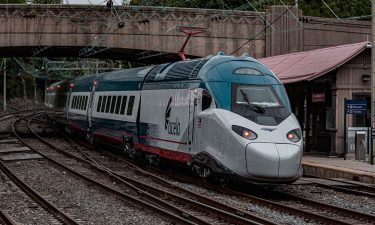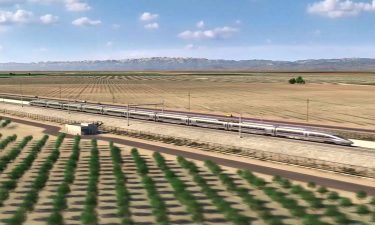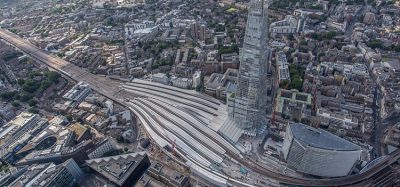High-speed rail in the United States: A golden opportunity
Posted: 6 May 2021 | Morgan Lindsay, Raymond Atkins, Terry Hynes | 2 comments
Raymond Atkins, Terry Hynes and Morgan Lindsay from the Transportation Group at Sidley Austin LLP detail why they believe that private investment is the way forward for high-speed rail in the U.S., but not without government support.


The current U.S. Transportation Secretary, Pete Buttigieg, recently shared his vision to see the United States “leading the world when it comes to access to high-speed rail.” Given the current state of passenger rail service in America, achieving that vision will be a Herculean task. America lags far behind Europe and Asia in high-speed rail development – only 33.9 miles (54.6km) of the current U.S. passenger rail network is capable of supporting train speeds in excess of 150mph.
America lags far behind Europe and Asia in high-speed rail development – only 33.9 miles (54.6km) of the current U.S. passenger rail network is capable of supporting train speeds in excess of 150mph.
Secretary Buttigieg is not the first American official to advocate for investment in high-speed passenger rail service. As far back as 1998, the U.S. Transportation Secretary at the time, Rodney Slater, presented a high-speed rail plan and allocated more than $30 million to support state-sponsored high-speed rail projects. In 2009, the then-Transportation Secretary, Ray Lahood, issued a policy paper calling for construction of a high-speed rail network connecting major U.S. cities, and Congress appropriated more than $8 billion for that purpose. Two years later, the Obama Administration announced an ambitious plan to make high-speed rail service available to 80 per cent of Americans within 25 years.
Getting to the root of the problem
Despite longstanding recognition that the nation’s passenger rail system needs to be modernised, these initiatives failed to gain traction. The reasons why are rooted in geography, technology and government policy decisions dating back to the post-World War Two era.
The United States is a vast country, stretching more than 3,000 miles from the coast of Maine to southern California. In the 1950s, Congress acted to connect the nation by approving construction of a 41,000-mile interstate highway system. The interstate highway network (which has grown to nearly 50,000 miles) gave rise to America’s love affair with the automobile – the number of registered cars in the United States increased astronomically from 25 million in 1950 to more than 287 million in 2020. The advent of passenger jet travel in the late-1950s created another exciting alternative to intercity travel by train.
The post-war surge in highway and air travel had a devastating impact on America’s passenger trains.
The post-war surge in highway and air travel had a devastating impact on America’s passenger trains. Freight railroads, which were losing business to a burgeoning trucking industry made possible by the new interstate highway network, abandoned their passenger trains in a desperate (and, ultimately, unsuccessful) effort to avoid bankruptcy. Congress responded to this crisis by nationalising passenger rail service in a federally owned railroad, Amtrak. While that policy decision preserved service to communities that otherwise would have lost access to passenger rail, the increasing popularity of automobile and air travel made it impossible for Amtrak to become self-sustaining.
…increasing public awareness of the harmful effects of climate change and ever-worsening congestion on America’s highways have created a golden opportunity to ignite a rail renaissance in the United States.
Today, increasing public awareness of the harmful effects of climate change and ever-worsening congestion on America’s highways have created a golden opportunity to ignite a rail renaissance in the United States. High-speed passenger rail has assumed a prominent place in the conversation about how to combat climate change and improve the nation’s transportation infrastructure. American policymakers are at a critical crossroads: how will the nation seek to implement Secretary Buttegieg’s vision for a world-leading high-speed passenger train system?
Is a government-run high-speed network the answer?
One approach would be to expand and upgrade Amtrak’s existing service. Early indications are that this option – creating a government-run high-speed rail network – may be favoured by policymakers. While the Biden Administration’s massive infrastructure plan includes $80 billion for rail, the lion’s share of those funds are earmarked for Amtrak. But a high-speed rail strategy based solely on Amtrak’s government-operated train service is doomed to fail.


The Acela is Amtrak’s flagship high-speed service.
The United States has an abysmal track record when it comes to government-run passenger rail service. Amtrak operates year after year at a loss, costing U.S. taxpayers nearly $100 billion since its inception. Despite massive subsidies, Amtrak trains (with the exception of its Acela service in the Northeast Corridor) rarely operate on time. Past federal spending to ‘upgrade’ Amtrak services has yielded only modest increases in train speeds, typically 10mph. Such marginal benefits hardly seem worth the price. Likewise, billions of dollars in federal funding for California’s 800-mile high-speed rail project have, after more than a decade, produced nothing more than partial construction of a small segment between Merced and Bakersfield – a “railroad to nowhere” that provides no transportation benefits for major cities like Los Angeles and San Francisco. In both cases, government control over rail construction projects has resulted in endless delays, massive cost overruns and minimal return on taxpayer investment.
Moreover, Amtrak’s existing network is ill-suited to serve as the foundation for a state-of-the-art U.S. high-speed rail system. Most Amtrak trains operate over tracks that are shared with freight and/or commuter railroads. The physical characteristics of those tracks – including grade, curvature and weight of rail – were designed to move heavy freight cars at slower speeds. Conversely, the design characteristics of high-speed rail systems are incompatible with heavy-haul freight operations. Even if existing shared tracks could be upgraded to support high-speed trains, commingling slow-moving freight trains and passenger trains operating at speeds in excess of 150mph would be a recipe for disaster. That is why virtually all high-speed passenger trains operate on dedicated tracks that are not shared with other trains.
The potential of private investment
The success of America’s privately-owned freight railroads provides a model for creating a world-class high-speed passenger rail network in the United States.
There is a better way. America’s freight railroads are the safest and most productive in the world. They were built by entrepreneurs who recognised the need for, and potential of, a privately-owned rail freight sector. Elimination of unnecessary government regulation enabled the freight railroads to recover from the travails of the post-war era and to innovate in ways that deliver fast and reliable service to the many industries that rely on rail freight to move their goods. The U.S. rail freight network is operated and maintained without government subsidies. While most new investment in rail freight infrastructure is privately financed, carriers have partnered with government to fund improvements where opportunities to benefit both the freight network and broader public objectives present themselves.


Private investors are seeking to develop high-speed rail lines in California / Credit: California High-Speed Rail Authority
The success of America’s privately-owned freight railroads provides a model for creating a world-class high-speed passenger rail network in the United States. Today, private investors are seeking to develop high-speed rail lines in California, Nevada, Texas, Florida and Maryland. These modern-day rail entrepreneurs have the ability to make prudent investment decisions that are free from the political compromises that delay – and, inevitably, increase the cost of – government-controlled projects. Once constructed, market forces will spur these privately-run passenger railroads to offer competitive rates, convenient schedules and a superior passenger experience.
This is not to suggest that there is no role for the United States government to play in the development of a high-speed rail network. To the contrary, government must implement policies that create incentives for private investors to risk the billions of dollars required to bring their projects to fruition.
The need for government support
The first, and most important, step that government must take to encourage the development of privately-owned high-speed passenger rail lines is to streamline the environmental and permitting review process. The environmental review of the ‘DesertXpress’ high-speed train between southern California and Las Vegas took more than six years, prompting the original investors to withdraw from the project. The proposed high-speed line between Dallas and Houston, Texas, was subjected to similarly lengthy environmental and safety reviews. Constructing an interstate rail line requires a multi-year permitting process before the federal Surface Transportation Board. Such interminable regulatory hurdles discourage investors from committing capital to projects that are likely to take a decade or longer to generate any return on investment. While it is certainly appropriate to evaluate the transportation merits, safety and environmental impact of these new rail lines, there is no reason why the government review process cannot be completed in two years (or less) without undermining the public interest.
The federal government must [also] act to pre-empt state and local efforts to derail meritorious high-speed rail projects.
The federal government must also act to pre-empt state and local efforts to derail meritorious high-speed rail projects. While cities to be served by a high-speed train almost always support construction of the line, communities along the route where the train will not stop typically oppose the project. Opponents utilise state and local legislative and judicial processes to place obstacles in the path of unwelcome high-speed trains, causing delays and increasing the project’s ultimate cost. Federal pre-emption of state and local laws that enable opponents to frustrate high-speed rail development efforts would eliminate another major hurdle for private investors seeking to build high-speed lines in the United States.
Finally, the federal government should partner with the developers of privately-owned high-speed rail projects by assisting them in obtaining access to capital. Constructing a high-speed line requires a massive upfront capital investment. Given the number of years required to bring a high-speed rail project to an operational state, obtaining construction capital from conventional commercial financing sources is not feasible. In Europe and Asia, governments supported the development of high-speed rail lines through both direct and indirect financing arrangements. For the reasons discussed in this article, private ownership is the route most likely to achieve a world-class passenger rail network in the United States. Nevertheless, the federal government can make an impactful contribution to the success of meritorious private high-speed rail projects by providing capital support in the form of grants or low-interest loans.
In summary
The imperative to respond to the threat of climate change provides a singular opportunity for the United States to pursue Secretary Buttegieg’s vision for a world-class passenger rail system. America’s experience with rail freight provides a roadmap for that pursuit – private entrepreneurs stand ready to build and operate the first high-speed trains on the North American continent. Now, government must do its part by adopting policies that reduce regulatory red tape, pre-empt state and local efforts to defeat high-speed rail projects for parochial reasons and assist proponents of meritorious projects in obtaining access to capital.
Raymond Atkins, Terry Hynes and Morgan Lindsay practice law in the Transportation Group at Sidley Austin LLP in Washington, DC. The opinions expressed in this article are those of the authors and not of Sidley Austin LLP or any of the firm’s clients, or Russell Publishing Ltd.
Stay Connected with Global Railway Review — Subscribe for Free!
Get exclusive access to the latest rail industry insights from Global Railway Review — all tailored to your interests.
✅ Expert-Led Webinars – Gain insights from global industry leaders
✅ Weekly News & Reports – Rail project updates, thought leadership, and exclusive interviews
✅ Partner Innovations – Discover cutting-edge rail technologies
✅ Print/Digital Magazine – Enjoy two in-depth issues per year, packed with expert content
Choose the updates that matter most to you. Sign up now to stay informed, inspired, and connected — all for free!
Thank you for being part of our community. Let’s keep shaping the future of rail together!
Related topics
Cargo, Freight & Heavy-Haul, Funding & Finance, High-Speed Rail, Infrastructure Developments, Operational Performance, Passenger Experience/Satisfaction, Regulation & Legislation, Route Development, Track Construction








The US has to move in a big way into light rail, snail rail, speed rail, EV buses, bicycling and walking. For each to replace fossil fuel driven driving and flying in its distance range, it will have to be free or extremely cheap; USers like their cars, even those who can’t afford them.
So we can’t afford for commuter transit and high speed rail to be for-profit. It will have to be done by the US or an interstate agency, whether Amtrak or other organization, with its own tracks, state-of-the-art technology, and a comprehensive network of all the modes linked together.
It needs to be done as part of a larger effort–a massive emergency climate mobilization/Green New Deal… or it won’t be of any use. It has to be done in the next 10 years or less or it’s likely to be impossible to implement in the face of increasing simultaneous serial disasters. And we need to find a way to do it without the ill-wishing anti-rail people and organizations making it as self-destructive and ineffective as Amtrak.
The bipartisan right wing has made it completely clear it will never allow any solutions at all to the climate or larger psycho-ecological crisis as long as it has power; the only way out I see is a massive peaceful revolution removing the right wing from power.
Reports the last few days—and years—show we’ve spent more than $21 trillion on oil wars and other military folies* since 2001, trillions more on corruption going to corporations and mbillionaires; many billions have been spent by those same corporations denying the reality of climate catastrophe and stymying solutions to it, using bribery, gerrymandering, voter suppression, election stealing, and other corruption, just in the last 5 years.
A comprehensive transportation system to be proud of, including HSR, electrified freight rail, and integrated local/regional systems could probably be built and operated indefinitely for $4.5-5 T, and would pay for itself in efficiency savings, health, death, and climate catastrophe and other costs avoided. We should get started with that revolution.
* Folie simultanée is a shared psychosis
The rest of the world moves on.
L0 Series Maglev: 374 mph. …
TGV POS: 357 mph. …
CRH380A Hexie: 302 mph. …
Shanghai Maglev: 268 mph. …
HEMU-430X: 262 mph. …
Fuxing Hao CR400AF/BF: 260 mph. …
Frecciarossa 1000: 245 mph.
Best to stay with 1865 technology, coal, fossil fuels, etc.
I use Amtrak on the east coast Richmond, DC, Maryland, Boston, etc, over flying, aka short hops. By the time I add in an extra hour for heavy traffic delays through bridge tunnels, hour early getting to the airport, the time wasted that is not really in the air, loading, queuing up, etc, it’s about as fast.
Unfortunately heading south, not north to DC, isn’t as convenient as train service is limited, mostly long haul travelers aka Florida, New Orleans.
High speed from Richmond to Raleigh NC would be nice. About 300 miles, it takes me about the same time to drive there as the time to fly there. The difference flying, puddle jumper with tight uncomfortable seats vs Amtrak’s Lazy boy like seats.